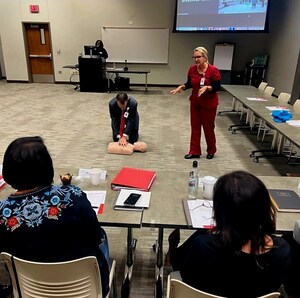Study Highlights:
- Drinking coffee and having sex are among eight “triggers” that appear to temporarily raise the risk of rupturing a brain aneurysm and suffering a stroke.
- Other triggers include exercising vigorously, drinking cola, blowing your nose, straining to defecate, being suddenly startled or angry.
- All triggers may result in a temporary increase in blood pressure
DALLAS, May 5, 2011 /PRNewswire-USNewswire/ -- From drinking coffee to having sex to blowing your nose, you could temporarily raise your risk of rupturing a brain aneurysm — and suffering a stroke, according to a study published in Stroke: Journal of the American Heart Association.
(Logo: http://photos.prnewswire.com/prnh/20100222/AHSALOGO )
Dutch researchers identified eight main triggers that appear to increase the risk of intracranial aneurysm (IA), a weakness in the wall of a brain blood vessel that often causes it to balloon. If it ruptures, it can result in a subarachnoid hemorrhage which is a stroke caused by bleeding at the base of the brain. An estimated 2 percent of the general population have IAs, but few rupture.
Calculating population attributable risk — the fraction of subarachnoid hemorrhages that can be attributed to a particular trigger factor — the researchers identified the eight factors and their contribution to the risk as:
- Coffee consumption (10.6 percent)
- Vigorous physical exercise (7.9 percent)
- Nose blowing (5.4 percent)
- Sexual intercourse (4.3 percent)
- Straining to defecate (3.6 percent)
- Cola consumption (3.5 percent)
- Being startled (2.7 percent)
- Being angry (1.3 percent)
"All of the triggers induce a sudden and short increase in blood pressure, which seems a possible common cause for aneurysmal rupture," said Monique H.M. Vlak, M.D., lead author of the study and a neurologist at the University Medical Center in Utrecht, the Netherlands.
Risk was higher shortly after drinking alcohol, but decreased quickly, researchers said.
"Subarachnoid hemorrhage caused by the rupture of an intracranial aneurysm is a devastating event that often affects young adults," Vlak said. "These trigger factors we found are superimposed on known risk factors, including female gender, age and hypertension."
Few people with IAs have symptoms before such a rupture, such as vomiting, vision problems, loss of consciousness, and especially severe headaches. Many have none. With the increasing use of neuroimaging techniques, more incidental aneurysms are being detected, researchers said.
The researchers sought to identify potential triggers and their level of risk. They asked 250 patients with aneurysmal subarachnoid hemorrhage to complete a questionnaire about exposure to 30 potential trigger factors in the period shortly before their event and their usual frequency and intensity of exposure to these triggers. They then assessed relative risk using a case-crossover design that determines if a specific event was triggered by something that happened just before it.
Although physical activity had triggering potential, researchers don't advise refraining from it because it's also an important factor in lowering risk of other cardiovascular diseases.
"Reducing caffeine consumption or treating constipated patients with unruptured IAs with laxatives may lower the risk of subarachnoid hemorrhage," Vlak said. "Whether prescribing antihypertensive drugs to patients with unruptured IAs is beneficial in terms of preventing aneurysmal rupture still needs to be further investigated."
The findings were limited by the retrospective design of the study and the average three weeks between subarachnoid hemorrhage and completion of the questionnaire, researchers said. Moreover, specifically asking for exposure in a particular time frame may have been limited by recall bias and including patients in a relatively good clinical condition could have led to survival bias.
Co-authors are Ale Algra, M.D., Ph.D.; Gabriel J.E. Rinkel, M.D., Ph.D.; Paut Greebe, R.N., Ph.D.; and Johanna van der Bom, M.D., Ph.D. Author disclosures are on the manuscript.
The Julius Center for General Health and Primary Care and the Department of Neurology of the University Medical Center in Utrecht, the Netherlands funded the study.
NR11 – 1071 (Stroke/Vlak/Algra)
Statements and conclusions of study authors published in American Heart Association scientific journals are solely those of the study authors and do not necessarily reflect the association's policy or position. The association makes no representation or guarantee as to their accuracy or reliability. The association receives funding primarily from individuals; foundations and corporations (including pharmaceutical, device manufacturers and other companies) also make donations and fund specific association programs and events. The association has strict policies to prevent these relationships from influencing the science content. Revenues from pharmaceutical and device corporations are available at www.americanheart.org/corporatefunding.
Editor's Note: May is Stroke Month and High Blood Pressure Awareness month. Managing high blood pressure is the most important thing you can do to lessen your risk for stroke.
Additional resources:
- Downloadable stock footage, animation and our image gallery are located at www.heart.org/news under Multimedia.
- For more on stroke, visit the American Stroke Association
- For more on high blood pressure, visit www.heart.org/hbp
CONTACT
Karen Astle: (214) 706-1392, [email protected]
Bridgette McNeill: (214) 706-1135, [email protected]
Julie Del Barto (broadcast): (214) 706-1330, [email protected]
SOURCE American Heart Association
WANT YOUR COMPANY'S NEWS FEATURED ON PRNEWSWIRE.COM?
Newsrooms &
Influencers
Digital Media
Outlets
Journalists
Opted In





Share this article